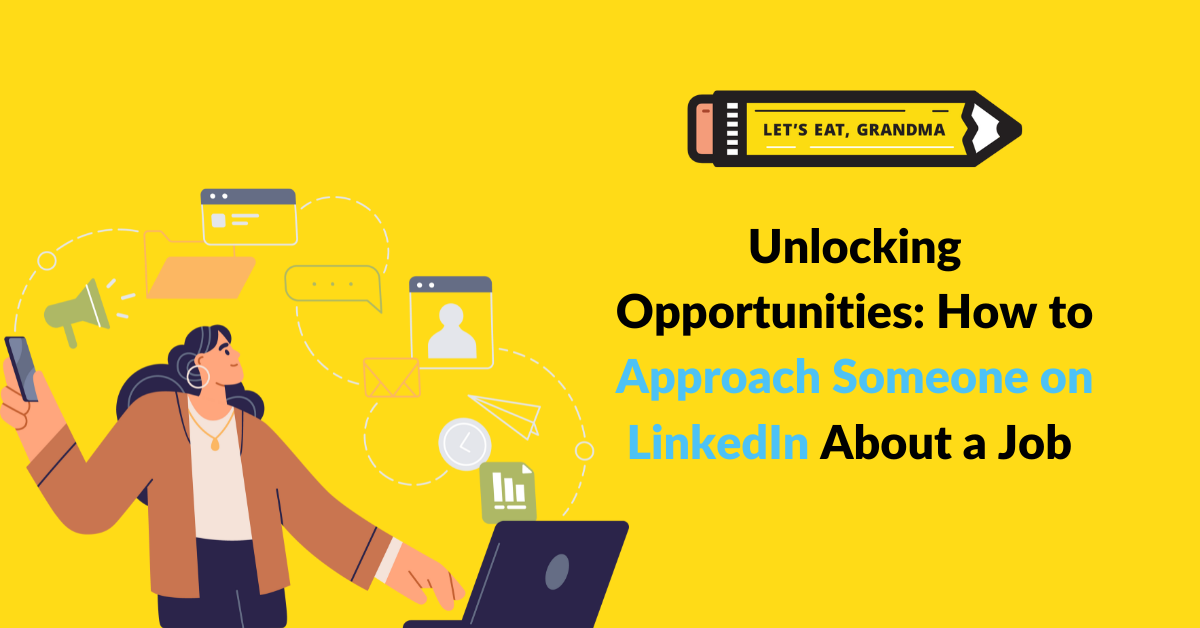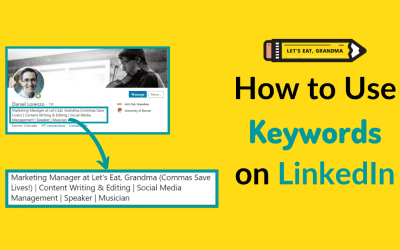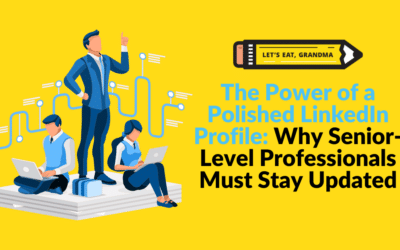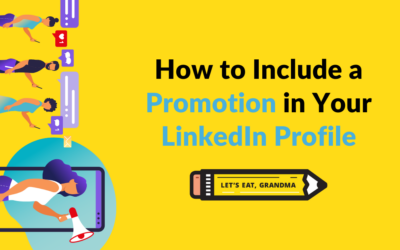Is there a job opportunity you’ve been eyeing on LinkedIn but need help landing? Here’s how to reach out to someone on LinkedIn about a job opportunity.
“Oh, I know the founder and he connected me with someone at the company!”
If you’ve ever heard these words come out of someone else’s mouth, you’ve no doubt felt a tinge of envy and wondered why these opportunities come so easily to some, while for others, the path to networking success appears much more challenging.
The reality of the job market today is that networking matters more than ever. 85% of jobs are filled through connections with other professionals and personal acquaintances, and 70% of employees received their current job through networking.

Photo by LinkedIn Sales Solutions on Unsplash
This means that if you want to get ahead in your career, it pays to understand the basics of professional networking – even if it feels a bit uncomfortable at first. One powerful tool for that purpose and one that happens to be less intimidating than other tactics is LinkedIn.
LinkedIn provides an invaluable opportunity to connect with professionals in any field and can be a great tool for job-seekers if used correctly. But the question is: how do you approach someone on LinkedIn about a job without coming off as spammy or pushy? That’s exactly what we’ll teach you how to do here.
1. Do your homework
The first step to go from having a passing thought about contacting someone you find on LinkedIn to actually reaching out to them and having a meaningful conversation is research and preparation.
Just like you’d do your due diligence when applying to a job via a job posting, you should start out by conducting research on the person and the company before reaching out. Get to know the person’s background, job history, and current role. That way, you can tailor your message accordingly.
More importantly, before you decide to message someone about a particular job, you should make sure that the job in question is a good match for your interests and qualifications. Double-check that you have the skills the employer is looking for so that you don’t waste their time or your own.
2. Add the person to your network
Once you’ve done the research and prepared yourself, if the person isn’t already connected to you on LinkedIn, you’ll need to first send them a connection request. To guarantee that it isn’t immediately declined, include a personalized note when you send it in.
In that note, say just enough to explain who you are and why you’re interested in connecting with them. Express genuine interest in their work, achievements, content, or the company they’re with. Anything that makes you “eligible” to be part of their network should be included.
For instance, if you’re reaching out to a marketing manager at a company you want to become an ads specialist for, your personalized note could look something like this:
Hi [Name], I’m a digital marketing enthusiast and recent graduate interested in becoming an ads specialist. I noticed your amazing work on the team at XYZ Company, and I wanted to connect with you to learn more about what it takes to become an expert in this capacity and potentially even explore opportunities with your team. I look forward to becoming part of your network.
It’s simple, not too long, and expresses your enthusiasm for their work. You’ve provided relevant information about yourself and your skills, as well as a genuine request for more information.

Photo by Christin Hume on Unsplash
3. Craft a compelling outreach message
Personalized invitations do better than generic ones, so chances are, your connection request will be accepted. After that, start drafting the outreach message.
Your outreach message should be brief and to the point, but also engaging. Start by introducing yourself and explaining why you’re getting in touch—including any details that might have inspired you to reach out to that person specifically.
Then, express your interest in the job or industry that you’re trying to break into, and highlight any relevant skills and experiences that can help them visualize your potential as a professional in the space.
Finally, be sure to include a call to action. like requesting an informational interview or asking for advice. Whatever it may be, make sure to give them an actionable ask so that they have something specific to respond to.
Here’s a short, but effective outreach LinkedIn message example:
Hi [Name]!
Thank you for connecting!
My name is John and I recently read your article on digital marketing trends for 2021. I’ve been working in the field for the past two years, focusing mainly on Adwords campaigns and SEO optimization. Your insights were incredibly valuable and inspiring, so I wanted to reach out and express my admiration for your work.
I’m also currently exploring new opportunities in this space and saw that your company is looking for a Digital Marketer. I was wondering if you would be willing to chat with me about any advice you might have regarding getting my foot in the door. I’ve been waiting for this kind of opportunity to come up and would appreciate any guidance you could offer.
Thanks for your time and I look forward to hearing from you soon.
Warmly,
John
You can use this example as a starting point when crafting your own message. It’s brief and to the point while hitting on all the key points in a way that’s engaging and not overwhelming. Remember that if you go on too long, the recipient will end up losing interest. Consider utilizing a LinkedIn message automation tool, such as Linked Helper, to streamline your messaging process. This tool can assist in sending personalized connection requests and follow-up messages efficiently, enhancing your outreach efforts by automating tasks and ensuring a consistent and targeted approach to your networking strategy.
Pro Tip: You should always be ready to send your resume upon request, so make sure it’s up-to-date and reflects your skill set and desired career path. To get the confirmation you need, get a free resume critique to present your career history in the best possible light.
4. Nurture the relationship
What’s important to remember about professional networking is that it doesn’t stop at the initial connection. You won’t send the outreach message and then call it a day. Instead, you need to continue engaging with the contact and build upon your relationship to keep the connection alive.
While there are no hard and fast rules, here are a few things you can do to continue fostering the relationship:
- Send timely follow-up messages after your initial message if you haven’t heard back
- Engage with their content and contribute with meaningful comments
- Attend industry events they’re involved in to stay up to date on their work
- Seek out and leverage any common connections or mutual contacts
And if the conversation between you and the contact is ongoing, you could:
- Share updates on your progress and any recent achievements to stay top of mind
- Offer any help or resources if applicable (for instance, share an industry report or helpful tool)
- Stay in touch even after an initial inquiry or ask is done through constant check-ins and small talk
By taking the time to engage with your contact, you’re showing them that you value their relationship and see it as a two-way street. This can go a long way in further deepening your connection and expanding your professional network in the long run.
5. Don’t take lack of responses & rejections personally
Finally, it’s essential to note that not every contact you reach out to will respond, and not every connection will pan out in the way you’d hoped. In these cases, it’s important not to take no responses or rejections personally–they’re a normal part of networking. You could be up against many variables influencing the outcome: timing, workloads, interests, lack of resources, and more.
Instead of dwelling on it, focus on the quality connections you’ve made and what you can learn from each interaction to add value in the future.
It’s also key to remain professional and stay respectful in your messaging regardless of the nature of the response (or lack thereof) you receive. This means being polite, understanding, and not pushing too hard if the answer is “no” or taking extended pauses in communication.
Sure, it’s okay to follow up and try to rekindle a connection, but it’s equally important to respect their boundaries and autonomy. Two follow-ups should be the maximum amount you send.
In conclusion
The hard part about networking isn’t necessarily the act of reaching out to people, but rather embracing the courage to do so. It requires resilience and perseverance to keep going despite the inevitable rejections and lack of responses that come with it.
To minimize the chances of these situations occurring and maximize your success, focus on curating quality connections rather than chasing quantity. Make sure you’re well informed and prepared for each networking exchange before jumping into it and show your contacts that you value their relationship by being intentional in your interactions.
And most importantly, take notes on what resonates with them and learn how to better refine your approach over time. The more you do, the more successful you’ll be in your job search.
It’s time to get networking!
Ready for more job search help?
Sign up for a free Senior Writer Resume Critique to see what’s holding you back from landing interviews. One of our top professional resume writers will give you personalized feedback on the top 3 items you can improve based on our expert practices!




